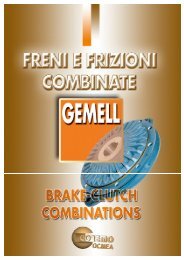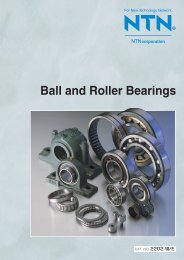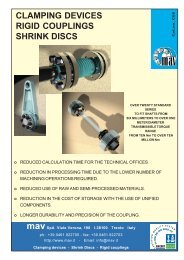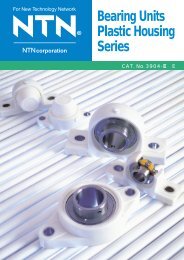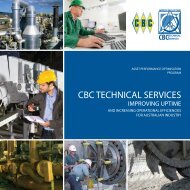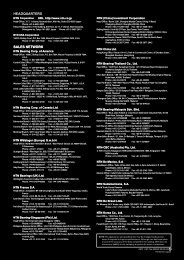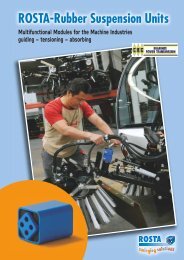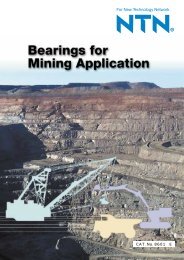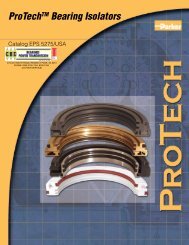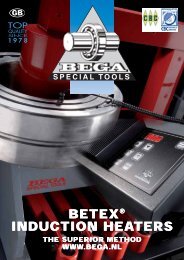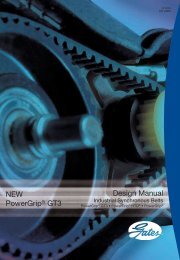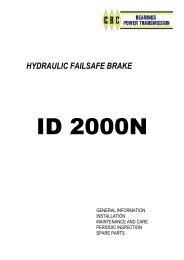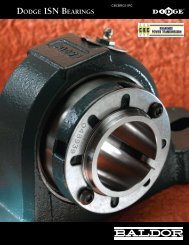Needle Roller Bearings - Ntn-snr.com
Needle Roller Bearings - Ntn-snr.com
Needle Roller Bearings - Ntn-snr.com
Create successful ePaper yourself
Turn your PDF publications into a flip-book with our unique Google optimized e-Paper software.
Technical Data<br />
NTN<br />
11. Technical Data<br />
11. 1 HL Bearing<br />
The form of bearing separation life can be mainly<br />
classified into the internal origin type and the surface<br />
origin type. Bearing separation of the surface origin type<br />
is said to occur in an inadequately lubricated area and it<br />
is widely recognized that the bearing separation life<br />
correlates to the oil film parameter that can be determined<br />
by "Elastic Fluid Lubrication Theory (EHL Theory)".<br />
This oil film parameter must be increased for controlling<br />
the surface origin type separation and, for that, the<br />
bearing manufacturers have made possible effort for<br />
better improvement of lubricant and for upgrading of the<br />
bearing rolling raceway surface roughness.<br />
In recent years it has been proposed by the relative<br />
field that the capability of forming an oil film on contact<br />
surfaces could be improved better by changing the form<br />
and directivity of surface roughness of machined parts.<br />
On the other hand, NTN developed successfully long<br />
life HL (High Lubrication) bearings under "Micro EHL<br />
Theory" as one of the countermeasures against surface<br />
origin type separation. And these HL bearings have been<br />
widely used in each field since developed.<br />
11.1.1 Basic concept of HL bearing<br />
Fig. 11.1 illustrates the basic concept of the HL<br />
bearing.<br />
In this Figure, the hatched area shows a contact<br />
portion deformed elastically and the dotted line shows the<br />
lubrication flow, based on "Internal lubrication fluid flow<br />
model in contact portion" disclosed by H.S. Cheng and<br />
others.<br />
Lubricant flow in (B) has a resistance greater than that<br />
in (A). This means that the quantity of a fluid existing<br />
internally in the contact portion increases. In other words,<br />
the thickness of an oil film formed on the rolling contact<br />
surface increases with increase of the fluid quantity.<br />
11.1.2 HL surface<br />
Fig. 11.2 is a magnified photo showing roller surface. In<br />
this Figure the blackened spots are micro recessed spots<br />
and, as seen from this Figure, a number of micro oil pots<br />
of around several tens mm exist at random. The recessed<br />
spots on this surface can be modified into any optional<br />
size and the number of spots by changing the machining<br />
conditions. Fig. 11.3 shows the bus line form of the HL<br />
surface, from which the depth of the micro recessed spots<br />
is nearly 1 mm.<br />
11.1.3 HL bearing application examples<br />
The HL surface-treated bearings are widely used in<br />
various fields. For example, they are used for car<br />
transmission, hydraulic devices, various reduction gears,<br />
etc.<br />
As an example of special application, HL surface<br />
treatment is applied to the special-purposed bearing for<br />
the rocker arm of car engine. This is highly appreciated<br />
as an effective seizure preventive measure.<br />
Fig. 11.2 Magnified photo showing roller surface<br />
A<br />
B<br />
1m<br />
0.1mm<br />
Fig. 11.1 Directivity of finished surface and lubrication fluid<br />
flow model<br />
Fig. 11.3 Bus line form of HL surface<br />
A-52




